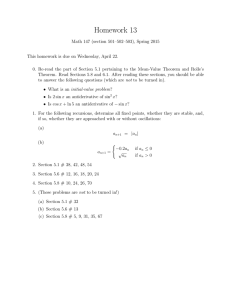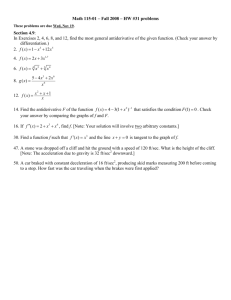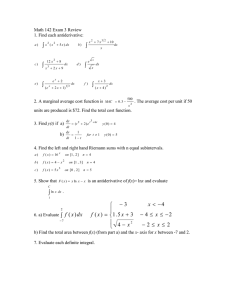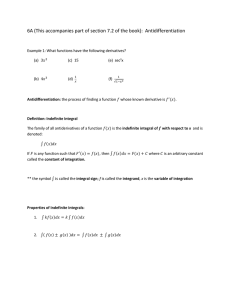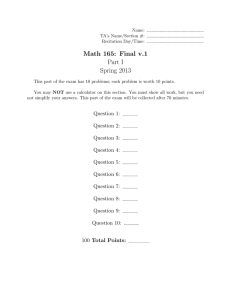MA 126 Antiderivatives and Substitution January 2015 Basic Antiderivative Formulas:
advertisement
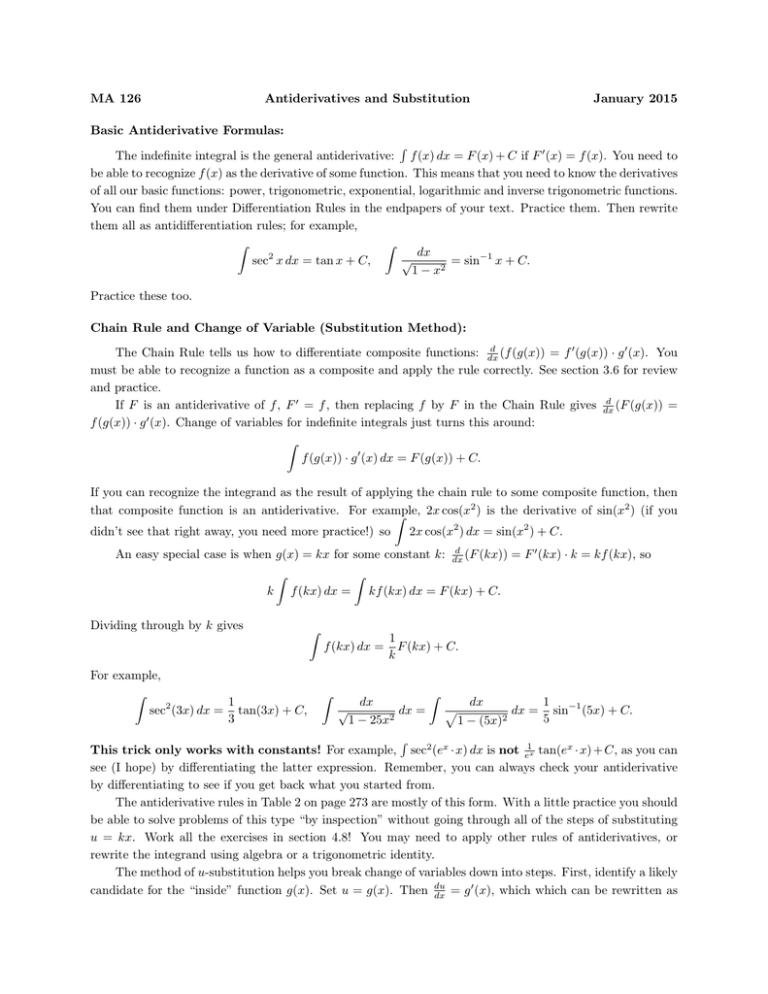
MA 126 Antiderivatives and Substitution January 2015 Basic Antiderivative Formulas: R The indefinite integral is the general antiderivative: f (x) dx = F (x) + C if F 0 (x) = f (x). You need to be able to recognize f (x) as the derivative of some function. This means that you need to know the derivatives of all our basic functions: power, trigonometric, exponential, logarithmic and inverse trigonometric functions. You can find them under Differentiation Rules in the endpapers of your text. Practice them. Then rewrite them all as antidifferentiation rules; for example, Z Z dx √ = sin−1 x + C. sec2 x dx = tan x + C, 1 − x2 Practice these too. Chain Rule and Change of Variable (Substitution Method): d The Chain Rule tells us how to differentiate composite functions: dx (f (g(x)) = f 0 (g(x)) · g 0 (x). You must be able to recognize a function as a composite and apply the rule correctly. See section 3.6 for review and practice. d If F is an antiderivative of f , F 0 = f , then replacing f by F in the Chain Rule gives dx (F (g(x)) = 0 f (g(x)) · g (x). Change of variables for indefinite integrals just turns this around: Z f (g(x)) · g 0 (x) dx = F (g(x)) + C. If you can recognize the integrand as the result of applying the chain rule to some composite function, then that composite function is an antiderivative. For example, 2x cos(x2 ) is the derivative of sin(x2 ) (if you Z didn’t see that right away, you need more practice!) so 2x cos(x2 ) dx = sin(x2 ) + C. An easy special case is when g(x) = kx for some constant k: Z k d dx (F (kx)) = F 0 (kx) · k = kf (kx), so Z f (kx) dx = kf (kx) dx = F (kx) + C. Dividing through by k gives Z f (kx) dx = For example, Z 1 sec2 (3x) dx = tan(3x) + C, 3 Z 1 F (kx) + C. k dx √ dx = 1 − 25x2 Z dx p 1− (5x)2 dx = 1 sin−1 (5x) + C. 5 R This trick only works with constants! For example, sec2 (ex · x) dx is not e1x tan(ex · x) + C, as you can see (I hope) by differentiating the latter expression. Remember, you can always check your antiderivative by differentiating to see if you get back what you started from. The antiderivative rules in Table 2 on page 273 are mostly of this form. With a little practice you should be able to solve problems of this type “by inspection” without going through all of the steps of substituting u = kx. Work all the exercises in section 4.8! You may need to apply other rules of antiderivatives, or rewrite the integrand using algebra or a trigonometric identity. The method of u-substitution helps you break change of variables down into steps. First, identify a likely 0 candidate for the “inside” function g(x). Set u = g(x). Then du dx = g (x), which which can be rewritten as R du = g 0 (x)dx = du f (u) du, and if you can find dx dx. Check to see if this results in an integral of the form an antiderivative of f . If not, consider making another choice of u or using another method. Start by looking at the most complicated part of the integrand and asking if it is a composite. You might try u = g(x) for expressions of the form sec(g(x)), ln(g(x)), eg(x) , (g(x))n (including, for example, p g(x) = (g(x))1/2 or 1/(g(x))3 = (g(x))−3 ). Take a quick scan to see if g 0 (x) is also there (up to aZconstant x dx multiple) before committing yourself to the choice of u. For example, u = 1 + x2 will work for 1 + x2 Z R R dx but not for . We can use u = cos x for cos2 x sin x dx but not for cos2 x dx (use a trig identity 1 + x2 instead.) Look again at the choices for u made in examples and homework problems 1–16 in section 5.5, and then try problems 17–70. Some of the later ones are challenging. For 38, 40–42, do some algebraic simplification first. For 41–48, look at Example 8: if the integrand looks like F (u) du but with some extra x’s left over, you may be able to write them in terms of u. If what you get is horribly complicated, consider another approach! You may need to look twice to see that the integrand can be written as a product dx 1 dx f (g(x)) · g 0 (x). In 55, = · = u−1 du with u = ln x. See also 59–66. x ln x ln x x
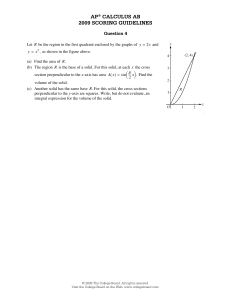
![Math 131 Practice Exam 3 on [ -1, 4].](http://s2.studylib.net/store/data/010538103_1-a851ef52d08f89241a99ddd9d94bbb2a-300x300.png)

